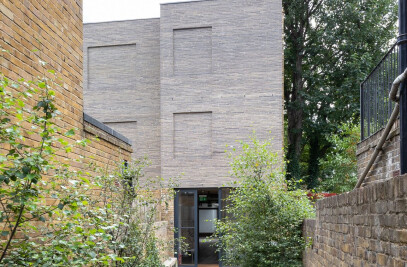Chris Dyson Architects have completed the refurbishment of a derelict gasworks into a 120sqm sustainable annex for contemporary living. The project is the extension to a nineteenth century stone building in the Gloucestershire countryside, and in an area of outstanding natural beauty. Located by a quiet, minor road, the gasworks was built in 1877 and formerly provided gas for lighting to a nearby country house. The building had been recently acquired by a client with a passion for restoring derelict buildings, and who wanted a house which met both their current and future needs. From its inception the brief for the new building focused on the need to reduce the overall environmental impact during the construction process, as well as meeting the future demands for heating and electricity.
While preserving and giving new life to the existing cottage, Chris Dyson Architects knew the cottage would require additional space to suit future needs of living, so the studio adopted a Cotswold Typology of the “Barn” to form a new contemporary single storey extension without over developing the cottage.
The new rusty steel barn is clad in CorTen steel, one of the most recycled building materials available. The steel envelope sits on a sustainably sourced timber frame and pays homage to the buildings industrial past, while creating a striking contrast to the main building. The new annex is deliberately distinct from its surroundings but with creative use of materials and massing works gently with the landscape encircling an external courtyard. The annex is single storey, with a circular tower element which recalls the former gas storage cylinder on the site. The tower now houses study spaces. Insulation to both walls and the roof is taken to a higher level than is required under the building regulations and is made up of Warmcell Insulation. This product is manufactured from recycled waste paper which is converted to a green, eco-friendly high performance insulation. The annex is accessed by a link from the kitchen of the cottage and becomes a corridor connecting the en-suite bedrooms. Each bedroom is arranged to create a horseshoe, forming a courtyard around the back of the building.
Inside the annex, a glazed portico links four bedrooms with private services. Each room enjoys spectacular views onto the natural woodland. Large windows on the roofs allow high levels of daylight in the interior.
Harry Whittaker, Partner at Chris Dyson Architects said “This project has been a fascinating project tying together issues of sustainability, adaptation and alteration to a historic industrial structure and building within an area of outstanding natural beauty in the heart of the Cotswolds’’. The building is heated via an external air source heat pump. Air source heat pumps absorb heat from the outside air which can then be used to heat the underfloor heating system. Although not a truly renewable source of heating the system does significantly reduce the electrical demand to the building. This results in a lower home carbon emission which, with the photovoltaic panels fitted to the roof, means that the electrical demand is significantly lower than a conventional home.
Chris Dyson Architects embraced the client’s culture of sustainability by applying the most efficient techniques offered by building performance science. Passive ventilation, a biomass boiler room, rain water harvesting systems and solar power panels dramatically reduce the environmental impact of the development.
The refurbishment of the Gasworks Cottage is a valuable addition to Gloucestershire’s prestigious building stock. It brings an imaginative, yet sensitive, redevelopment of the site with a scheme that champions the concept of sustainability in the area.

































